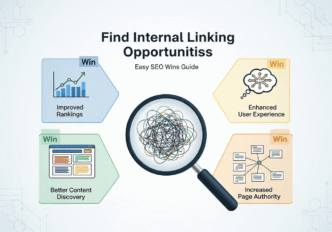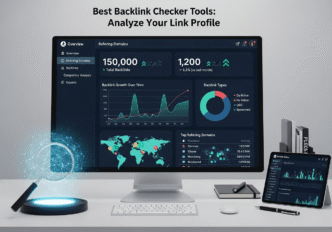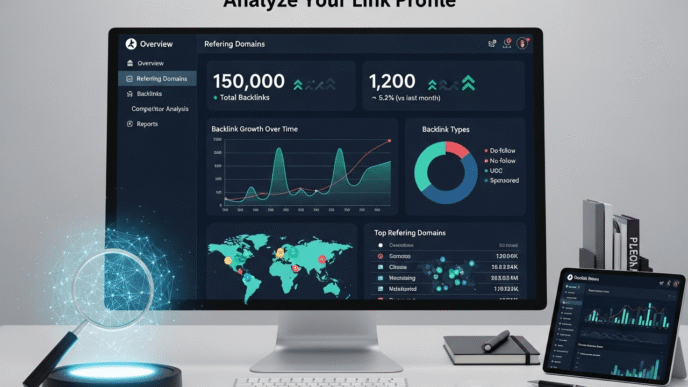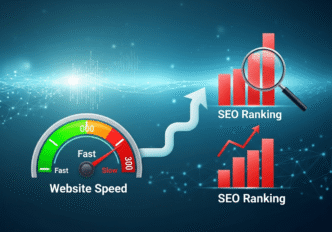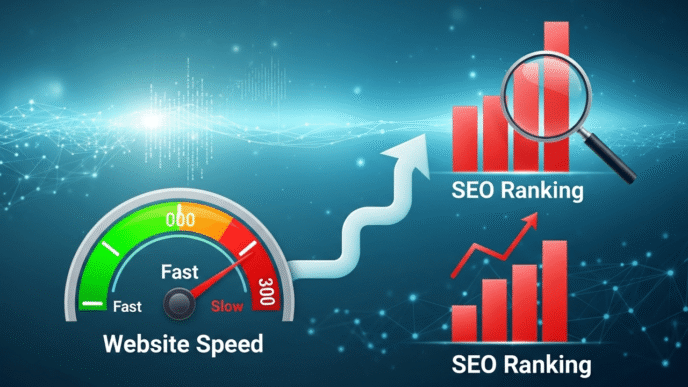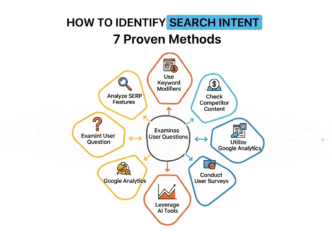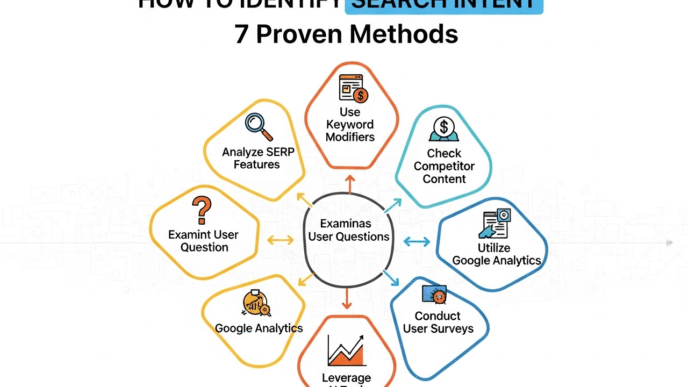Picture this: You’ve published 100+ amazing blog posts, but they’re like hidden treasures buried in a digital desert. Your readers can’t find them, Google’s crawlers are missing them, and your best content is collecting virtual dust. Sound familiar? This is the classic case of missing internal linking opportunities – the low-hanging fruit that could transform your SEO performance overnight.
Most website owners sit on goldmines of content without realizing they’re just a few strategic links away from doubling their organic traffic. If you’ve ever wondered why some of your best articles barely get any visits while mediocre content from competitors ranks higher, the answer often lies in one simple factor: they’ve mastered the art of finding and implementing strategic internal connections.
Today, we’re diving deep into how to find internal linking opportunities that will unlock your content’s true potential. By the end of this guide, you’ll have a systematic approach to discover hidden linking gems and turn your website into an interconnected powerhouse that both users and search engines absolutely love.
Table of Contents
ToggleWhat Are Internal Linking Opportunities and Why Do They Matter?
Internal linking opportunities are strategic chances to connect relevant pages within your website that aren’t currently linked together. Think of them as missing bridges in your content ecosystem – potential connections that could help users discover more valuable content while distributing SEO power throughout your site.
These opportunities exist everywhere on your website, hiding in plain sight. Maybe you wrote about “keyword research” in 2022 and “content optimization” in 2024, but never connected these obviously related topics.
Studies by Ahrefs show that websites with strategic internal linking see an average 40% increase in organic traffic within six months. That’s not just correlation – it’s causation driven by better crawlability, improved user experience, and smarter SEO power distribution.
The Hidden Cost of Missing Internal Linking Opportunities
Every missed connection is a missed opportunity for:
- Better user experience through logical content progression
- Improved page authority distribution across your site
- Enhanced content discoverability for both users and search engines
- Increased session duration and lower bounce rates
💡 Pro Tip: The most successful websites treat internal linking like a nervous system – every piece of content is connected to related pieces, creating a web of knowledge that search engines can easily understand and users can effortlessly navigate.
How to Find Internal Linking Opportunities: A Step-by-Step Approach
Finding internal linking opportunities doesn’t require expensive tools or technical wizardry. It requires a systematic approach and the right mindset. Let’s break down the process into manageable steps.
Step 1: Perform a Comprehensive Content Audit
Start with a complete content audit to understand what you’re working with. Create a spreadsheet listing every important page on your website, including:
- Page titles and URLs
- Primary keywords and topics
- Current organic traffic
- Number of existing internal links
This audit becomes your treasure map, showing you exactly where opportunities exist.
Step 2: Identify Your Content Themes and Topic Clusters
Look for natural groupings in your content. If you’re a digital marketing blog, you might have clusters around:
- SEO optimization (keyword research, on-page SEO, technical SEO)
- Content marketing (content strategy, content creation, content distribution)
- Social media marketing (platform strategies, content creation, analytics)
Related content within these clusters should be interconnected like a spider web, with each piece supporting and referencing the others.
What Tools Can Help You Find Internal Link Opportunities?
The right tools to find internal link opportunities can accelerate your discovery process dramatically. Let’s explore both free and premium options.
Free Tools That Deliver Results
| Tool | Best For | Key Features | Cost |
|---|---|---|---|
| Google Search Console | Link distribution analysis | Internal links report, page performance | Free |
| Google Analytics | User behavior insights | Content flow, page connections | Free |
| Screaming Frog (Free) | Basic site crawling | Link analysis, site structure | Free (500 URLs) |
Premium Tools for Advanced Analysis
| Tool | Monthly Cost | Best Features | Ideal For |
|---|---|---|---|
| Ahrefs | $99+ | Comprehensive link analysis, content gap analysis | Professional SEOs |
| SEMrush | $119+ | Content audit, internal linking suggestions | Agencies |
| LinkStorm | $29+ | Automated internal linking suggestions | WordPress users |
How to Use Google Search Console for Internal Link Discovery
Google Search Console’s “Links” report is a goldmine for internal linking opportunities:
- Navigate to Links → Internal links
- Sort pages by “Target page” to see which pages receive the most internal links
- Identify important pages with surprisingly few internal links
- Look for patterns in your highest-linked pages
Real-world example: A client discovered their product pages had almost no internal links from their blog content. Adding strategic links from educational blog posts to relevant products increased conversion rates by 34%.
How to Conduct an Internal Linking Audit Checklist?
A systematic internal linking audit checklist ensures you don’t miss any opportunities. Here’s a comprehensive approach:
Phase 1: Current State Analysis
Content Inventory:
- [ ] List all important pages (100+ words, valuable content)
- [ ] Categorize content by topic and intent
- [ ] Identify orphaned pages (pages with no internal links)
- [ ] Note pages with excessive internal links
Link Distribution Assessment:
- [ ] Analyze which pages receive the most internal links
- [ ] Identify important pages that are under-linked
- [ ] Map current internal link flow and patterns
- [ ] Document broken internal links
Phase 2: Opportunity Identification
Content Gap Analysis:
- [ ] Find related content that isn’t connected
- [ ] Identify supporting content for pillar pages
- [ ] Look for natural progression paths between articles
- [ ] Spot cross-selling/upselling opportunities
🔥 Expert Insight: According to Backlinko’s analysis of 1 million Google search results, pages with strong internal link structures rank an average of 2.5 positions higher than those with poor internal linking.
What Are Content Gaps for Internal Links?
Identifying content gaps for internal links reveals your biggest opportunities for improvement. These gaps represent missed connections that could significantly boost your SEO performance.
Common Types of Content Gaps
Thematic Gaps:
- Related topics that aren’t connected
- Supporting evidence or examples that could link to main articles
- Case studies that could link to methodology articles
User Journey Gaps:
- Awareness content not linking to consideration-stage articles
- Educational content not connecting to conversion pages
- Problem-focused articles not linking to solution-oriented content
The Topic Cluster Content Gap Analysis Method
Step 1: Map Your Existing Clusters Identify your main topic areas and list all related content.
Step 2: Identify Missing Connections Look for logical relationships that aren’t currently linked:
- Does your keyword research guide link to your content optimization article?
- Do your link building articles reference your comprehensive internal linking strategies?
Step 3: Prioritize by Impact Focus on connections that will help users complete their learning journey and distribute authority to important but under-performing pages.
How to Develop Internal Linking Strategy Planning?
Effective internal linking strategy planning transforms random link opportunities into a systematic approach that drives real business results.
The Strategic Framework
1. Define Your Content Hierarchy Establish clear levels in your content structure:
- Pillar pages: Comprehensive, authoritative guides (3,000+ words)
- Cluster content: Supporting articles that dive deep into specific aspects
- Supporting content: Additional resources, case studies, and examples
2. Implement the Hub-and-Spoke Model This proven approach maximizes SEO impact:
- Hub: Comprehensive pillar content that covers a topic thoroughly
- Spokes: Specific articles that link back to the hub and to each other when relevant
Real-World Strategy Implementation Case Study
The Challenge: A B2B SaaS company had 200+ blog posts but terrible internal link distribution.
The Strategy:
- Content audit revealed 15 main topic clusters
- Created strategic link paths from educational content to product pages
- Implemented hub-and-spoke linking within each cluster
The Results:
- 67% increase in average session duration
- 89% improvement in pages per session
- 34% boost in demo requests from organic traffic
For comprehensive guidance on implementing these strategies, our visual guide to internal linking SEO provides interactive tools and detailed frameworks.
Advanced Link Analysis Techniques
Mastering link analysis helps you understand not just where opportunities exist, but which ones will deliver the biggest impact.
The Authority Flow Analysis Method
Understanding Page Authority Distribution: Use tools like Ahrefs or SEMrush to identify:
- Pages with the highest authority scores
- Pages that receive the most external backlinks
- Content with the strongest social signals
These high-authority pages become your link distribution powerhouses – strategic starting points for sharing ranking power with other important content.
The User Behavior Analysis Approach
Google Analytics Insights:
- Behavior Flow reports: See how users naturally navigate your site
- Exit page analysis: Identify where users leave and add relevant internal links
- Search query analysis: Understand what users seek and link related content
Common Mistakes to Avoid When Finding Internal Linking Opportunities
Even with the best intentions, many marketers make critical errors that reduce the effectiveness of their internal linking opportunities.
Over-Optimization Red Flags
Anchor Text Repetition: Using the same keyword-rich anchor text repeatedly looks spammy and can trigger penalties.
Bad Example: Linking to your SEO guide with “SEO guide” from 15 different articles Good Example: Using variations like “comprehensive SEO resource,” “detailed optimization tutorial,” and “step-by-step SEO methodology”
Link Density Overload: Cramming too many internal links into short content dilutes their value.
Safe Guidelines:
- 3-5 internal links per 1,000 words of content
- Focus on user value over link quantity
Strategic Planning Mistakes
Random Linking Without Purpose: Adding internal links without considering user intent wastes opportunities and confuses visitors.
Solution: Always ask “Does this link help the user accomplish their goal?” before adding any internal link.
Tools for Automated Internal Linking Discovery
Automated tools can accelerate your internal linking opportunities identification dramatically.
WordPress Plugins for Automated Discovery
| Plugin | Price | Key Features | Best For |
|---|---|---|---|
| Link Whisper | $77/year | AI-powered link suggestions | Content-heavy WordPress sites |
| Internal Link Juicer | Free/€47 | Automated linking based on keywords | Blogs with consistent posting |
| Rank Math | Free/Premium | SEO optimization with internal link suggestions | Complete SEO management |
Measuring Success and Optimization
You can’t improve what you don’t measure. Here’s how to track the success of your internal linking opportunities implementation.
Key Performance Indicators (KPIs) to Track
Traffic and Engagement Metrics:
- Pages per session: Should increase as internal links improve content discovery
- Average session duration: Better internal linking keeps users engaged longer
- Bounce rate: Strategic links should reduce single-page exits
SEO Performance Indicators:
- Keyword ranking improvements for pages receiving new internal links
- Click-through rates from search results to internally linked content
- Page authority distribution: More even distribution of ranking power
The 90-Day Measurement Framework
Days 1-30: Document current performance and implement priority opportunities Days 31-60: Analyze initial results and expand to medium-priority opportunities
Days 61-90: Scale successful patterns and develop systematic processes
📊 Success Benchmark: Most websites see 15-25% improvements in average session duration and 20-40% increases in pages per session within 90 days of strategic internal linking implementation.
Your Action Plan for Finding Internal Linking Opportunities
Ready to transform your website with strategic internal linking opportunities? Here’s your implementation plan:
Week 1: Foundation and Discovery
- Complete content inventory using Google Search Console
- Identify topic clusters and relationship opportunities
- Use our interactive SEO analysis dashboard to prioritize high-impact opportunities
Week 2: Strategic Implementation
- Add internal links from top 10 highest-traffic pages to under-linked content
- Implement hub-and-spoke linking within strongest topic clusters
- Fix broken internal links and optimize anchor text
Week 3: Expansion and Enhancement
- Analyze user behavior flow in Google Analytics
- Add strategic links supporting natural user progression
- Study competitor internal linking strategies
Week 4: Monitoring and Optimization
- Set up performance tracking for internal link click-through rates
- Review early results and identify best-performing strategies
- Develop systematic processes for ongoing opportunity discovery
Final Thoughts: Transform Your SEO with Strategic Internal Linking
Finding and implementing internal linking opportunities is one of the most cost-effective ways to boost your SEO performance. Unlike external link building, which depends on others, internal linking is entirely within your control and can deliver immediate results.
The key is approaching it systematically rather than randomly. Start with a comprehensive content audit, identify your topic clusters, and implement strategic connections that genuinely help users while distributing SEO authority throughout your site.
Remember, the most successful websites don’t just publish great content – they create interconnected content ecosystems where every piece supports and amplifies the others. Your internal linking strategy planning should focus on building these logical connections that serve both users and search engines.
For advanced implementation strategies and interactive tools to optimize your approach, explore our comprehensive internal linking resource that includes practical frameworks and real-time performance tracking capabilities.
The difference between websites that struggle and those that dominate search results often comes down to one thing: strategic internal linking. You now have the knowledge and tools to find those hidden opportunities – it’s time to put them to work.
Frequently Asked Questions About Finding Internal Linking Opportunities
Q: How often should I look for new internal linking opportunities? A: Conduct a comprehensive audit quarterly, but add internal links to new content as you publish it. Also, review your top-performing content monthly to identify new linking opportunities.
Q: What’s the biggest mistake beginners make when finding internal linking opportunities? A: Adding links randomly without considering user intent or content relevance. Every internal link should provide genuine value to the reader and make logical sense in context.
Q: How many internal linking opportunities should I implement at once? A: Start with 20-30 high-impact opportunities in your first month, then add 10-15 new internal links monthly as part of your ongoing SEO audit process.
Q: Can I have too many internal links on a page? A: Yes. Aim for 3-5 internal links per 1,000 words of content. Too many links dilute their individual value and can hurt user experience.
Q: Do internal links from old content to new content help SEO? A: Absolutely! Adding internal links from established, high-authority content to newer pages is one of the most effective ways to boost new content’s search performance.
Q: Should I prioritize internal linking opportunities by traffic or by business goals? A: Ideally both. Focus on opportunities that either boost traffic to high-converting pages or help distribute authority from high-traffic pages to important business content.
Q: How long does it take to see results from internal linking opportunities? A: Most websites see initial improvements in user engagement metrics within 2-4 weeks, with more significant SEO improvements appearing within 60-90 days of consistent implementation.

